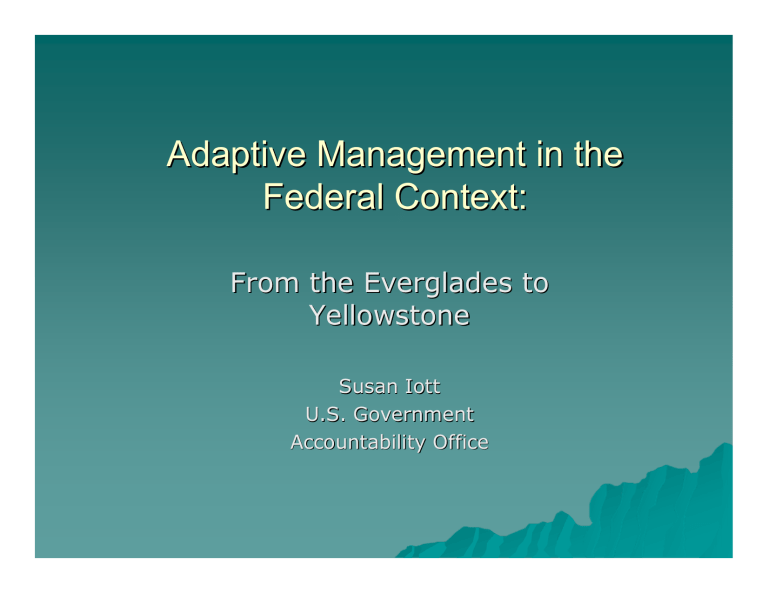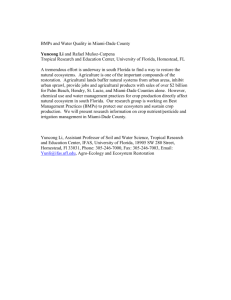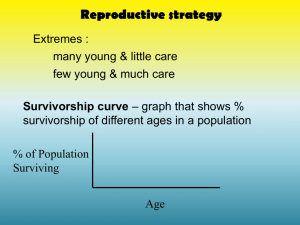Adaptive Management in the Federal Context: From the Everglades to Yellow
advertisement

Adaptive Management in the Federal Context: From the Everglades to Yellowstone Susan Iott U.S. Government Accountability Office Adaptive Management Adaptive management is a strategy for managing natural resources that focuses on learning and adapting management actions. The approach seeks to make decisions around multiple or conflicting objectives and dynamic natural systems with uncertain responses to management action. Climate is one of many factors involved. The approach is based on the work of C.S. Holling, Carl Walters, and Kai N. Lee. Adaptive Management Used by Federal Agencies Federal land and resource management agencies have numerous situations in which to apply adaptive management. Used for difficult, large natural resource management programs such as the Grand Canyon Adaptive Management Program (1994-5), Northwest Forest Plan (1994), the South Florida Ecosystem Management Restoration (1996), and the Interagency Bison Management Plan in the Yellowstone Ecosystem (2000). Department of the Interior Guidance from 2007 Adaptive management is a structured, explicit decision process that involves (1) engaging stakeholders, (2) identifying the problem, (3) specifying objectives and tradeoffs, (4) identifying a range of alternatives from which to select, (5) specifying assumptions about resources, (6) projecting consequences of alternative actions, (7) identifying key uncertainties, (8) measuring risk for consequences, (9) accounting for impacts of decisions/actions, and (10) accounting for legal constraints. Recent Department of the Interior Guidance Adaptive management is not appropriate if: – Decisions cannot be revisited; – Monitoring cannot be provided; – Irresolvable conflicts exist; – Legal constraints exist; or – Risks are too high. Two examples Interagency Ecosystem Bison Management South Florida Ecosystem Restoration Interagency Bison Management Plan Each winter, bison migrate from Yellowstone National Park to better grazing areas outside the Park. The bison and elk of the Greater Yellowstone Ecosystem are the last known reservoir of brucellosis in the U.S. The disease is transmitted when the bison (or elk) shed bacteria in fields where cattle also graze. Montana has been struggling to keep its brucellosis-free status, Wyoming and Idaho have just reestablished their bison-free status after losing it due to suspected wildlife transmissions. Two areas in Montana are the subject of a management plan because of the potential of bison to mingle with cattle. Interagency Bison Management Plan Interagency Bison Management Plan In 1995, Montana sued the U.S. because of fears it might lose its brucellosis free status through the bison. The state and federal governments negotiated a plan to manage the bison to settle the lawsuit. The plan, signed in 2000, involves hazing bison back into the park and capturing, testing, and slaughtering most of those that do not move back into the park. Later phases of the plan allow a small number of bison to be outside the park in certain areas. Interagency Bison Management Plan The plan involves adaptive management because it involves – monitoring the bison migration patterns, – developing a vaccine and remote delivery system, and – testing bison for brucellosis, and over time, allowing more to remain outside the park (increasing risk tolerance). Interagency Bison Management Plan The agencies have not succeeded in using an adaptive process because – they don’t have clear objectives, – they conduct research and monitoring without a plan to say where the results fit into decisions being made about the bison, – they don’t have a feedback loop to bring scientific and monitoring results back to the decision makers. South Florida Ecosystem Restoration South Florida is an 18,000 square mile area that includes the Everglades, Kissimmee River, Lake Okeechobee, and many water bodies such as Biscayne Bay and Florida Bay. The different ecosystems provide habitat and food for many threatened and endangered species, as well as 6.5 million people. South Florida Ecosystem Restoration Before human intervention, water flowed slowly from Lake Okeechobee south through the Everglades to Florida Bay--this absorbed all the water from hurricanes and released it throughout dry periods. Development and drainage of key areas in the wetlands allowed agriculture to flourish, as well as homebuilding. Since at least the 1980s, environmental groups and state and federal agencies have been working on a restoration plan to restore the timing and flow of water. South Florida Ecosystem Restoration South Florida Ecosystem Restoration The restoration plan has an adaptive management framework for: (1) development of performance indicators of the key factors causing the ecosystem to be degraded and to be restored, (2) long-term monitoring to track the status of trends in measures and indicators, research to understand factors that affect the measures and indicators, and assessment of monitoring results, and (3) feedback so that managers will know what to change. South Florida Ecosystem Restoration Key adaptive management tools were not available five years ago, including a monitoring plan for all parts of the ecosystem (wetlands were well covered) and models for different parts of the ecosystem (Florida Bay). The restoration has a Science Coordination Team, but the team lacked the ability to effectively coordinate science and bring it back to the Task Force for decision making. It did not have a plan for research, consult with managers about key decisions and input, or synthesize information about decisions. Decision Making How does adaptive management fit within an agency’s decision process? In other words, how do decision makers and others learn and make their decisions adaptive? Policy decision making processes In policy making, decisions are made in an iterative process that involves several steps (Lasswell and McDougal): – – – – – – – Intelligence Promotion Prescription Invocation Application Evaluation Termination Intelligence Phase Many different parties involved--the agencies, public, interest groups, and scientists in different capacities. Typically, a specific group of people is identified to make decisions—including decisions to try different adaptive experiments. Scientific information may come from different agencies. Scientific information can be unorganized, as in the case of Yellowstone, or more organized, as in the case of South Florida. But it needs to be explicitly brought into the intelligence phase and reevaluated regularly. Intelligence Phase The case studies show that the land and resource management agencies already work in situations with large amounts of uncertainty. GAO’s work on climate change on federal lands shows that climate information is one more area for land managers to consider in their management. Promotion Phase Scientists are part of the effort to highlight relevant information for decisions--in particular, which information is better than other information. The idea of adaptive management can emphasize uncertainty and the need to experiment, learn, adapt, and not treat decisions as final. Prescription, Invocation, Application These phases involve the formal decision to be made--a law, policy, or legal opinion--and the decision to apply it to a particular situation. Scientists can be involved in the process if there is a scientific board or judgment to be made. In the case of the South Florida case, for example, the Science Coordination Team will set up a peer review process to review the science underpinning a problem about which a decision has been made. Prescription, Invocation, Application In the South Florida case, a panel of scientists is to monitor the results of different water releases on species using indicators. They can raise the need to change water releases to the Task Force. The Task Force, whose members represent federal, state, and local agencies, make the decision what to do about water flow. In the case of the Yellowstone bison, there is not a mechanism for scientists to raise concerns to decision makers in the same way. There is no Task Force or management group for the plan. Evaluation and Termination There is a particular role for scientists in evaluating natural resource programs and whether or not they are achieving its intended results. That role involves objectives, indicators, monitoring, and assessment. Evaluation also involves an assessment of people’s values and whether or not they are being met by the decision or policy. Conclusions Adaptive management in a federal context needs to pay particular attention to who are the leaders making decisions--and who are the leaders of the program involved. A geographic focus helps organize participants from many different agencies. Science needs to be organized in a way to provide information on an ongoing basis to an iterative decision making process. This means an emphasis on indicators and monitoring--as well as science to help interpret indicators. Conclusions Adaptive management requires commitment to the process and funding to enable it. But agencies have lots of work and priorities to fund. It also requires that scientists need to be able to synthesize their information for input into the decision process. Interaction with decision makers about what decisions will need to be made and what evidence might be relevant to a decision can help to make a feedback loop between scientists and the decision makers.



